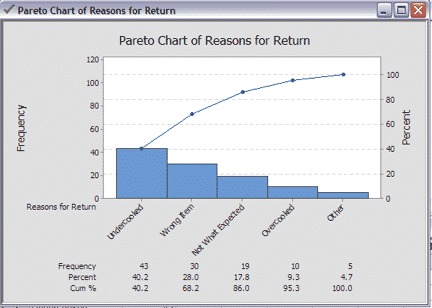

#PARETO CHART MINITAB FREE#
After you graph is generated, copy and paste the chart on your project!ĭownload free excel template for pareto chartįrom the cause and effect analysis (matrix chart), the following data with associated scores were seen for the reasons that could delay the takt time (here, the time is taken for customer’s check out). Do not change anything in the red and yellow space.

While editing please only use the green space. This graph performs the Pareto analysis for 15 items if you want to perform analysis for a lesser number of items please delete unwanted numbers of green rows, scroll down and also delete an unwanted number of red rows. In the excel template enter the cause of the problem/items and frequency in green boxes. Step 4: Draw and label the left vertical axis. Step 3: Determine the cumulative-percent of total. Step 2: Re-order the contributors from the largest to the smallest.
#PARETO CHART MINITAB DOWNLOAD#
Instead, download this Pareto chart graph from here and start drawing the chart entering only causes and frequency. Step 1: Total the data on effect of each contributor, and sum these to determine the grand total. We will not be going around steps to draw the Pareto chart as this will take a lot of time. There are many explanations for drawing a Pareto chart and steps. The Pareto principle could be applied to almost anything in our daily life-Ģ0% of your present activity determines 80% of your futureĨ0% of customer complaints arise from 20% of your products and services.Ĩ0% of the delays could be managed by reviewing 20% of the tasks.Ģ0% of your time is responsible for 80% of the result.Ģ0% of your products and services account for 80% of your profit.Ģ0% of your sales force produces 80% of your company revenues. This also helps to identify the core problems and bottlenecks of problems and also improve customer services. With productivity comes profitability in which you focus on those 20% of the items that are responsible for more profits thus allowing you to focus on profit-generating items. You can also focus to remove those 20% of the items are responsible for 80% of the unproductivity. Pareto chart leads to increased productivity by focusing your attention on the topics/resources that help to achieve maximum efficiency. Or, in quality terms, 80 percent of the losses come from 20 percent of the causes. That is, everyone who knows that Pareto charts are a type of bar chart ordered by bar size to help you to determine which bars. We conduct various training programs Statistical Training and Minitab. It is based on Pareto analysis developed by Vilfredo Pareto who coined it as an “80/20 rule,” which postulates that roughly speaking, 20 percent of the people own 80 percent of the wealth. Pareto chart is simple to understand, highlights the most frequently occurring.
#PARETO CHART MINITAB PLUS#
O’Reilly members experience live online training, plus books, videos, and digital content from nearly 200 publishers.A Pareto chart is an analytical tool which can be used for both Quantitative and Qualitative data. Get Industrial Statistics with Minitab now with the O’Reilly learning platform. in Fill Pattern and Borders and Fill Lines, first choose the Custom option.


 0 kommentar(er)
0 kommentar(er)
